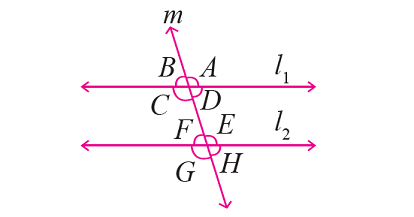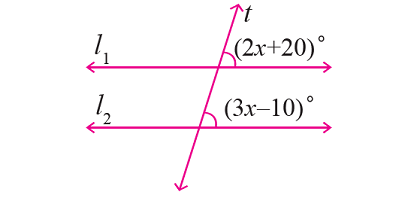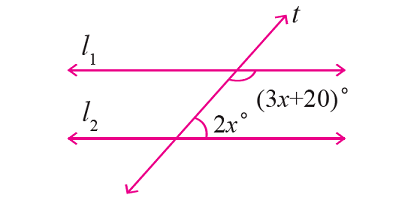PARALLEL LINES WORKSHEET
Subscribe to our ▶️ YouTube channel 🔴 for the latest videos, updates, and tips.
Problem 1 :
The slopes of the two lines are 7 and (3k + 2). If the two lines are parallel, find the value of k.
Problem 2 :
If the following equations of two lines are parallel, then find the value of k.
3x + 2y - 8 = 0
(5k + 3)x + 2y + 1 = 0
Problem 3 :
Find the equation of a straight line is passing through (2, 3) and parallel to the line 2x - y + 7 = 0.
Problem 4 :
Verify, whether the following equations of two lines are parallel.
3x + 2y - 7 = 0
y = -1.5x + 4
Problem 5 :
Verify, whether the following equations of two lines are parallel.
5x + 7y - 1 = 0
10x + 14y + 5 = 0
Problem 6 :
In the figure given below, let the lines l1 and l2 be parallel and m is transversal. If ∠F = 65°, find the measure of each of the remaining angles.

Problem 7 :
In the figure given below, let the lines l1 and l2 be parallel and t is transversal. Find the value of x.

Problem 8 :
In the figure given below, let the lines l1 and l2 be parallel and t is transversal. Find the value of x.


Answers
1. Answer :
If two lines are parallel, then their slopes are equal.
3k + 2 = 7
Subtract 2 from each side.
3k = 5
Divide each side by 5.
k = 5/3
2. Answer :
3x + 2y - 8 = 0
(5k + 3)x + 2y + 1 = 0
If the two lines are parallel, then their general forms of equations will differ only in the constant term and they will have the same coefficients of x and y.
To find the value of k, equate the coefficients of x.
5k + 3 = 3
Subtract 3 from each side.
5k = 0
Divide each side by 5.
k = 0
3. Answer :
Because the required line is parallel to 2x - y + 7 = 0, the equation of the required line and the equation of the given line 2x - y + 7 = 0 will differ only in the constant term.
Then, the equation of the required line is
2x - y + k = 0 -----(1)
The required line is passing through (2, 3).
Substitute x = 2 and y = 3 in (1).
2(2) - 3 + k = 0
4 - 3 + k = 0
1 + k = 0
k = - 1
So, the equation of the required line is
(1)-----> 2x -y - 1 = 0
4. Answer :
3x + 2y - 7 = 0
y = -1.5x + 4
In the equations of the given two lines, the equation of the second line is not in general form.
Let us write the equation of the second line in general form.
y = -1.5x + 4
1.5x + y - 4 = 0
Multiply by 2 on both sides,
3x + 2y - 8 = 0
Now, let us compare the equations of two lines,
3x + 2y - 7 = 0
3x + 2y - 8 = 0
The above two equations differ only in the constant term.
So, the equations of the given two lines are parallel.
5. Answer :
5x + 7y - 1 = 0
10x + 14y + 5 = 0
In the equation of the second line 10x + 14y + 5 = 0, the coefficients of x and y have the common divisor 2.
So, divide the second equation by 2
(10x/2) + (14y/2) + (5/2) = (0/2)
5x + 7y + 2.5 = 0
Now, let us compare the equations of two lines,
5x + 7y - 1 = 0
5x + 7y + 2.5 = 0
The above two equations differ only in the constant term.
So, the equations of the given two lines are parallel.
6. Answer :

From the given figure,
∠F and ∠H are vertically opposite angles and they are equal.
Then, ∠H = ∠F -------> ∠H = 65°
∠H and ∠D are corresponding angles and they are equal.
Then, ∠D = ∠H -------> ∠D = 65°
∠D and ∠B are vertically opposite angles and they are equal.
Then, ∠B = ∠D -------> ∠B = 65°
∠F and ∠E are together form a straight angle.
Then, we have
∠F + ∠E = 180°
Plug ∠F = 65°
∠F + ∠E = 180°
65° + ∠E = 180°
∠E = 115°
∠E and ∠G are vertically opposite angles and they are equal.
Then, ∠G = ∠E -------> ∠G = 115°
∠G and ∠C are corresponding angles and they are equal.
Then, ∠C = ∠G -------> ∠C = 115°
∠C and ∠A are vertically opposite angles and they are equal.
Then, ∠A = ∠C -------> ∠A = 115°
Therefore,
∠A = ∠C = ∠E = ∠G = 115°
∠B = ∠D = ∠F = ∠H = 65°
7. Answer :

From the given figure,
∠(2x + 20)° and ∠(3x - 10)° are corresponding angles.
So, they are equal.
Then, we have
(2x + 20)° = ∠(3x - 10)°
2x + 20 = 3x - 10
Subtract 2x from each side.
20 = x - 10
Add 10 to each side.
30 = x
8. Answer :

From the given figure, ∠(3x + 20)° and ∠2x° are consecutive interior angles.
So, they are supplementary.
Then, we have
(3x + 20)° + 2x° = 180°
3x + 20 + 2x = 180
Simplify.
5x + 20 = 180
Subtract 20 from each side.
5x = 160
Divide each side by 8.
x = 32
Subscribe to our ▶️ YouTube channel 🔴 for the latest videos, updates, and tips.
Kindly mail your feedback to v4formath@gmail.com
We always appreciate your feedback.
About Us | Contact Us | Privacy Policy
©All rights reserved. onlinemath4all.com

Recent Articles
-
10 Hard SAT Math Questions (Part - 44)
Jan 12, 26 06:35 AM
10 Hard SAT Math Questions (Part - 44) -
US Common Core K-12 Curricum Algebra Solving Simple Equations
Jan 07, 26 01:53 PM
US Common Core K-12 Curricum Algebra Solving Simple Equations -
10 Hard SAT Math Questions (Part - 4)
Jan 05, 26 06:56 PM
10 Hard SAT Math Questions (Part - 4)
